When and how to harvest garlic: the optimal time for digging winter and spring varieties
Say what you like, but you can't do without garlic in the kitchen, after all, it is a plus for any dish, except for compote. That is why it is so important to always have it on hand and in reserve. As you know, it is the winter variety of garlic that is immediately used for food and for conservation, and spring garlic, although it is much smaller and more delicate in taste, is used for storage. It is quite clear that it is more expedient to grow both varieties, because while one, more precisely the winter one, is already ready for use, the other, of course, the spring one is only gaining strength. Naturally, the timing of harvesting winter and spring garlic is different. As a rule, they largely depend on the weather conditions of the current season: how quickly the earth warmed up, what the temperature was.
However, if you dig up garlic too sooner or later, then various negative processes will begin to occur with it, which will negatively affect its storage in winter, so you need to choose the right timing for harvesting a spicy crop from the garden.
All these dacha problems will be discussed in our article.
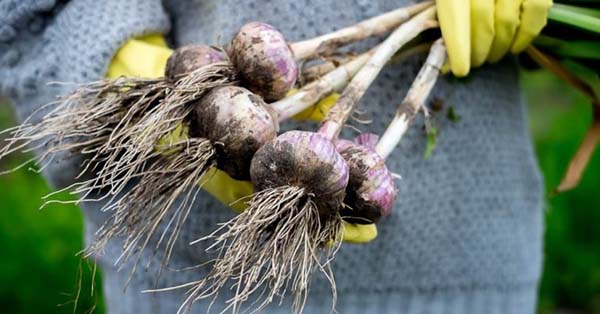
Content
When to harvest winter garlic and how to dig it up to store it
The decision of the summer resident to start harvesting garlic should be quite mature and well thought out. It will be necessary to correctly take into account not only the signs of the readiness of the harvest, but also correctly determine the time and methods of harvesting.
Harvest time: signs of readiness
The timing of harvesting winter garlic, as a rule, falls on at the beginning-second half of July and continue until early August.
However, there are different varieties of winter garlic, which differ in terms of ripening - early (ready within 3 months after germination) and late (slightly less than 4 months).
Also, the timing of harvesting winter garlic may also depend on what kind of garlic were planted in the fall, in other words, on the number of its fractions. So, single-toothed heads ripen much earlier, and even faster than early-maturing varieties. Next, the garlic ripens, which were planted with small cloves, then medium and larger ones.
Experienced gardeners recommend that before harvesting, perform some actions aimed at better ripening of garlic:
- In the last month, significantly reduce watering, and stop altogether 1-2 weeks before harvesting. This is done to prevent rotting processes in the soil.
- In about a couple of days, you should well loosen and clear (weed) the soil in the garlic beds.
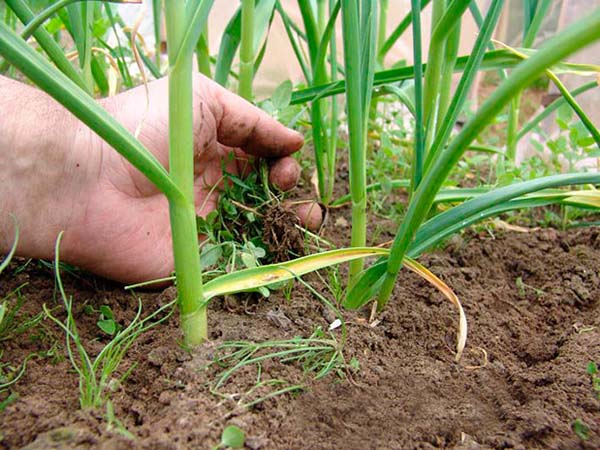
- For a week or 10 days, if desired, you can cut off or cut off all leaves starting to turn yellow.
- Tie, and then break off the arrows so that the plant does not waste its vitality on ripening the seeds, but gives all the nutrients to the ripening of the heads. In this case, it is necessary to leave a couple of arrows as beacons, so to speak, samples.
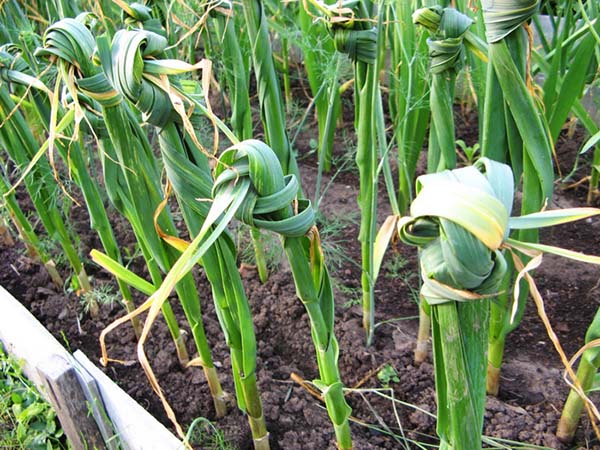
It is possible to determine whether winter garlic is ripe and whether it is necessary to harvest by its appearance:
- The first sign of ripening garlic is yellowing of its leaves (tips) and especially drying of the lower leaves. When they completely begin to turn yellow, then this is a clear signal that the crop must be harvested as soon as possible.
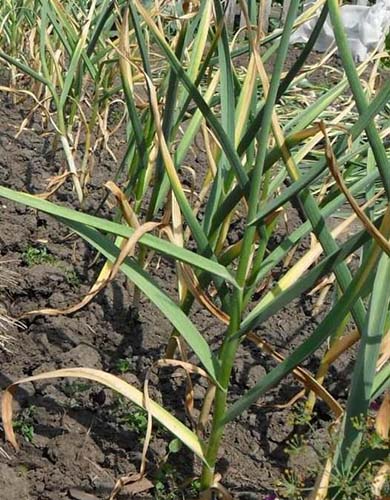
- Pay attention to the top garlic heads (inflorescences), in which the bulbs ripen. If the arrow with the seeds is completely straightened and is already starting to crack (although it is better to have time to collect it when it has not yet cracked), then the crop is ready for harvest. If it's too early, the arrow remains curved.
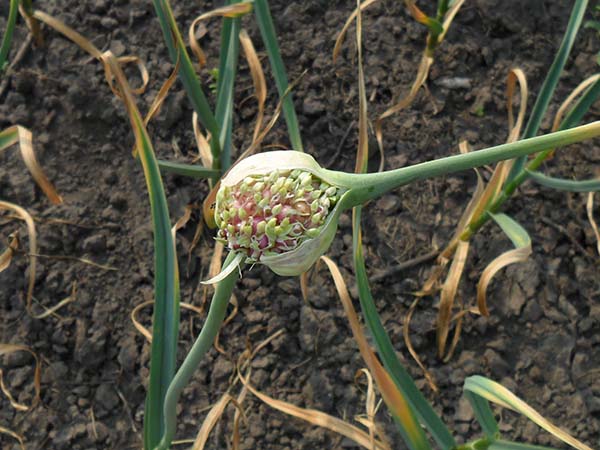
Advice! If you have planted the same variety (of the same ripening period), then you can always dig up one head to check.
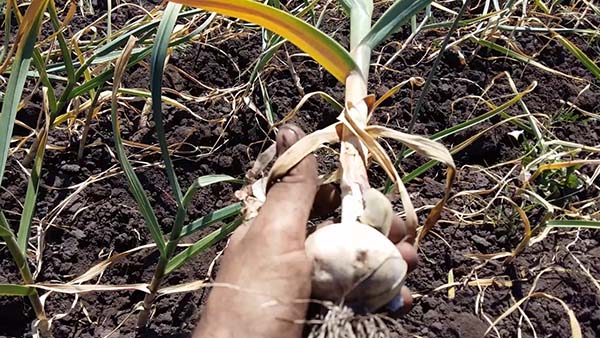
Note! Winter garlic is available as arrow and non-arrow.
Thus, when you notice that the leaves of the garlic have noticeably turned yellow, and the arrows have straightened, the scales have begun to crack slightly and bulbs appear, then it's time to start harvesting, and it is advisable to do this within a week.
If you do not rush or delay in harvesting the spicy vegetable, it will overripe, the bulb will crack and begin to disintegrate into separate slices. It is extremely important here that the shelf life in this case will decrease (although not fatally).
Video: harvesting garlic on time
How to dig up crops correctly
Advice! Like many other garden manipulations, it is better to harvest garlic in the early morning or late afternoon, in dry, clear and warm weather.
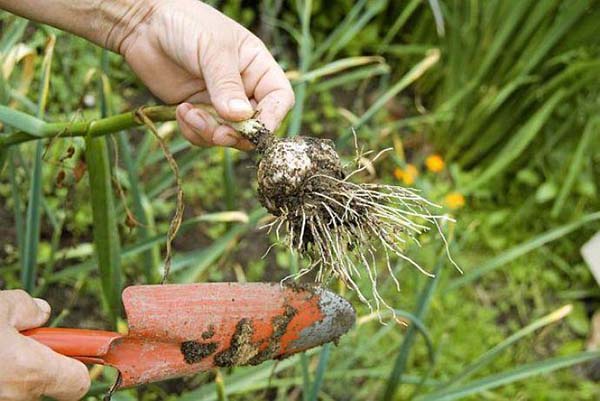
Direct cleaning, or rather, digging out the garlic must also be done correctly:
- It is not recommended to pull out the green part with your hands, because at this point watering stops, which means that the ground can be very dry at the time of its collection, and you can pull out the stem, and the head will remain in the ground.
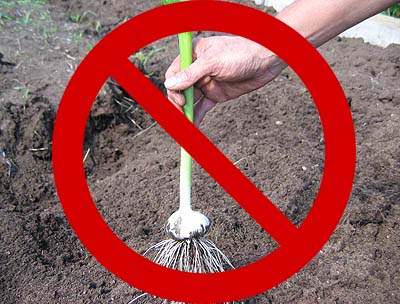
- Most optimal -take a shovel (or a pitchfork, or maybe a small scoop), carefully dig plant and already pull it out with your hands.In this case, you do not need to set the shovel at an angle, otherwise you can damage the bulb (this generally applies to the digging of all bulbous plants).
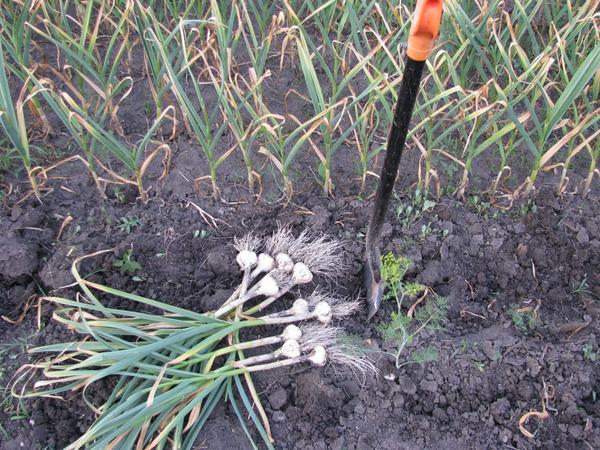
Video: when and how to harvest garlic
Harvest preparation for long storage
Once you have dug up all of the garlic, you will need to properly prepare it for storage. Here are some rules and tips, in other words, what you need to do before putting the heads in storage:
- If you pull out the garlic to which a lot of earth is stuck, do not knock on the shovel when trying to clean. If you damage its roots and bottom, then even small dents can become a source of infection, and then you will have to forget about long-term storage of this head. Better to gently brush off the dirt with your hands, tapping your palm very lightly.
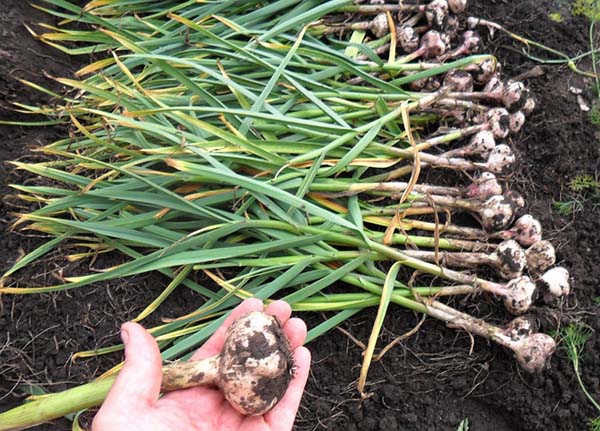
- Stems and sticking out of the head roots no need to cut off. The beard and green mass should remain so as not to injure the plant once again.
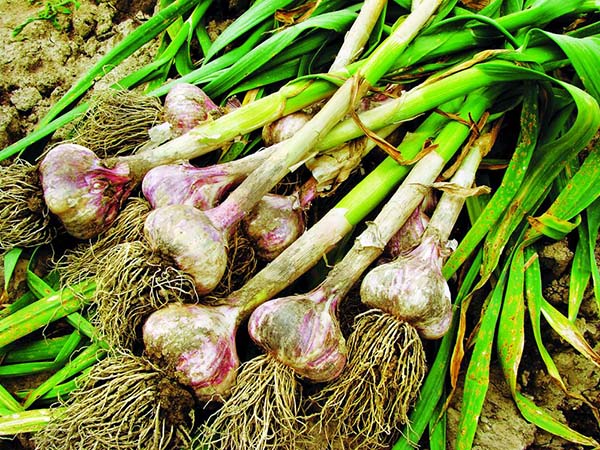
- Then put all the crops in a box to carry them closer to your home or veranda. Although some gardeners leave the garlic to dry right in the garden.
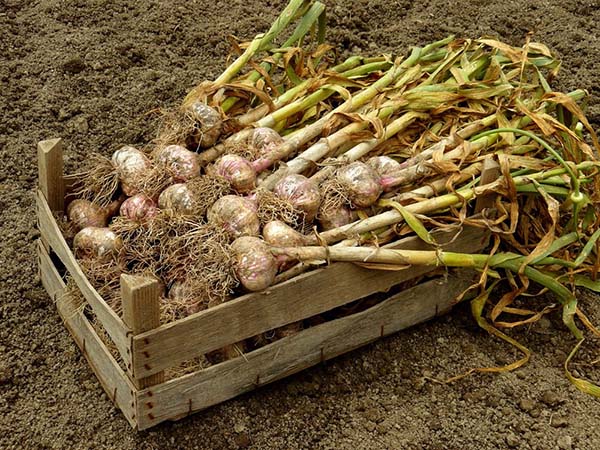
- Now you need to go somewhereput the garlic to dry so that its stems and roots are completely dry... Preferably in a warm room (for example, in the attic, but it must be ventilated) or under a canopy for 10-14 days (sometimes even up to 3 weeks), or can be dried in special ventilated dryers. A simple rule of thumb: the drier the better!
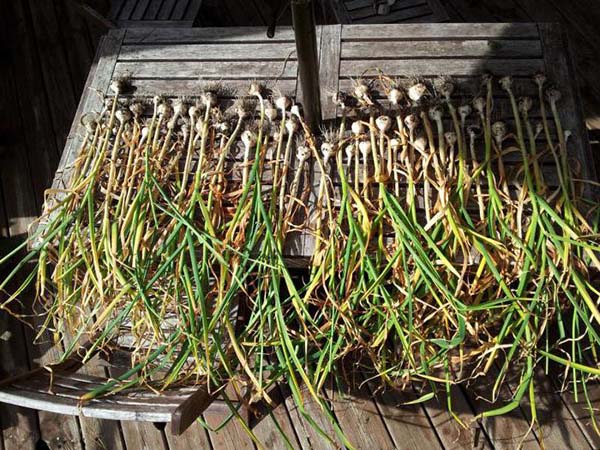
- If the weather permits, then you can hang the garlic to dry in the open air.
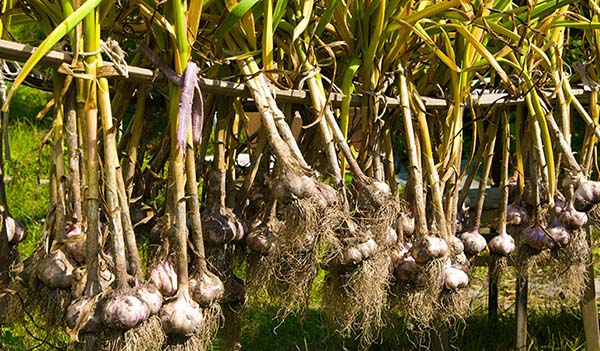
- Additionally there is no need to rinse or process the headssince the remainingthe dirt will dry up, and the whole thing will fly off.
- When the heads are well dry, they can cut off the stems (tops), but you should definitely leave a stump with a length of about 5, or better 10 centimeters(cut it off completely, and the garlic will definitely rot), and a little root beard (about 1 cm). But if you plan on storing garlic in braids or bunches, then there is no point in cutting off the stems.
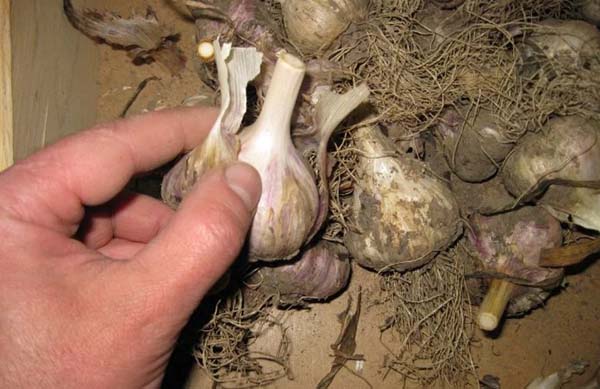
By the way! After you harvest the crop, you will have free space in the garden, which would be nice to take something up. If you haven't decided yet, then read our article about what is better to sow after garlic to the freed bed.
Video: how to properly prepare garlic for storage
When to harvest spring garlic
It is easy to guess that the harvest of garlic planted in spring (spring) is harvested later than that planted in autumn before winter (winter). As a rule, the term for digging out the heads of spring is in mid-August and ends somewhere in mid-September.
It is also easy to determine that spring garlic is ripe and ready to harvest, since the signs are the same (with one exception):
- The plant no longer has new leaves, and the old ones turn yellow.
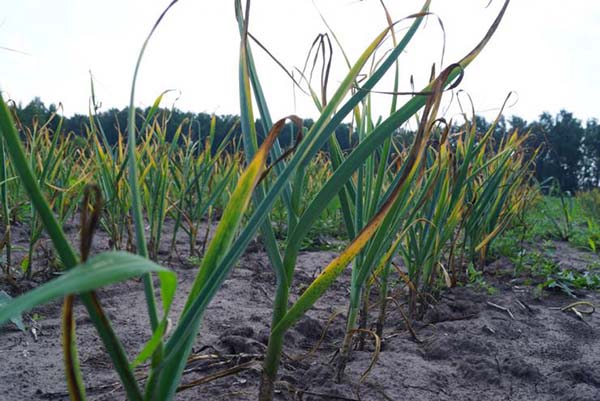
- The neck becomes very soft, so the stem of the plant lies on the ground (as a rule, non-shooting varieties are sown as spring garlic).
By the way! If you are guided by the Lunar calendar, then you need to choose a dry sign, preferably on the waning moon.
If you give the spring garlic to overripe, then because of the autumn rains, its young roots may begin to grow, which will definitely negatively affect its keeping quality and the usefulness of the spicy heads.
How to store garlic at home in winter
It is important not only to determine the timing of collection, to properly dig up the plants from the garden, but also to be able to store the garlic heads for a long time.
Note! Read about how to do this in our article. on how to store garlic at home in winter.
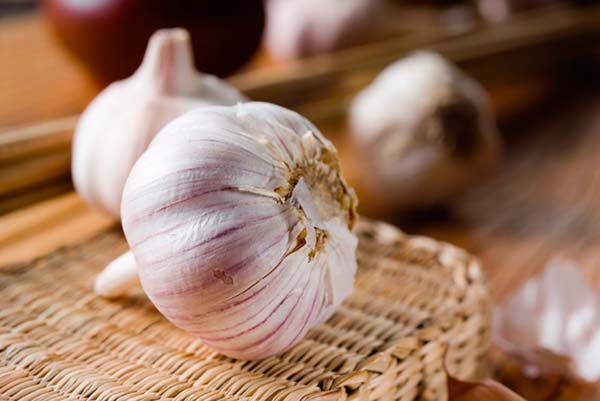
Thus, the algorithm of action is clear, and now a lot depends on knowing the correct harvest time for garlic, on the methods you have chosen to carry out direct harvesting and competent preparation of the harvest for storage. In short, get to work!
Video: how to dig up and store garlic

